Topologies of Touch
Lexicon
May 30, 2018artist contribution,
This experimental lexicon is by the participants of Open! Coop Academy’s study group Topologies of Touch. The study group – part of DAI Roaming Academy 2017–2018 – focused on touch and feel, the tactile and haptic, from philosophical and political standpoints and within cultural, artistic and social practices. Here you find a video summary of the public presentations of the study group in Athens in June 2018.
Our exploration of the body and touch in relation to politics, saw us turn to Erin Manning’s Politics of Touch: Sense, Movement, Sovereignty (2006) provoking a series of questions: How can we trace the ways in which touch informs and reforms the body in concepts such as violence, gender, race, sexuality, democracy and identity? How do sensing bodies run up against existing political structures? Can we resist paralyzing body-politics and cultivate ‘gestures’ of resistance?
Another substantive point of focus was hapticality in terms of ‘the capacity to feel through others’, proposed by Stefano Harney and Fred Moten in The Undercommons: Fugitive Planning & Black Study (2013). As they write, it is ‘a way of feeling through others, a feel for feeling others feeling you. This is modernity’s insurgent feel, its inherited caress, its skin talk, tongue touch, breath speech, hand laugh. This is the feel that no individual can stand, and no state abide. This is the feel we might call hapticality’.1
The image-text lexicon ‘Topologies of Touch’ includes entries that arise from the participants’ divergent individual practices, experiences and engagements in relation to the study group’s overarching topics. The various contributions conflict and coincide; they converge and touch each other. Hypatia Vourloumis’ text Ten Theses on Touch, or, Writing Touch has been another source of inspiration: ‘To write on touch is to recognize that one is touching and being touched.’2 This could also be applied to your reading of this lexicon, bringing into being a tactile constellation or topology of connected bodies.
Access
Marianna Maruyama

I’m going to use my hands to pat down the clothed areas of your body. Stand with your legs apart. I’ll use the backs of my hands on the sensitive areas, the buttocks and the zipper line. I’ll use two fingers to clear your collar and your waistline.
Not a request, but an announcement of impending contact, and an imperative.
Wherever we are on the (assembly) line,3 whether we are crossing a national border, trapped within an algorithmic logic, waiting at the gates of an institution, or exiting the ‘social’ factory, we are touched by others. With their scripted language they make distance from the bodies they touch; they refuse even to speak the names given to certain body parts. The body search, or pat down, is a procedure that inherently accuses in its demand for access. It is a predetermination of guilt, and a violent act directed against the body that finds success in incrimination. Stefano Harney writes about the immediate access demanded by a state form within logistical capitalism: ‘It does not call you out and by doing so make you a citizen. It just demands to see your ID, if it demands anything before it demonstrates access to your life with its violence.’4 This protocol for touching other bodies generates an uneven power relationship between the person touching and the one being touched, carried out under the rhetoric of safety and security.
Clap
Ines Marita Schärer
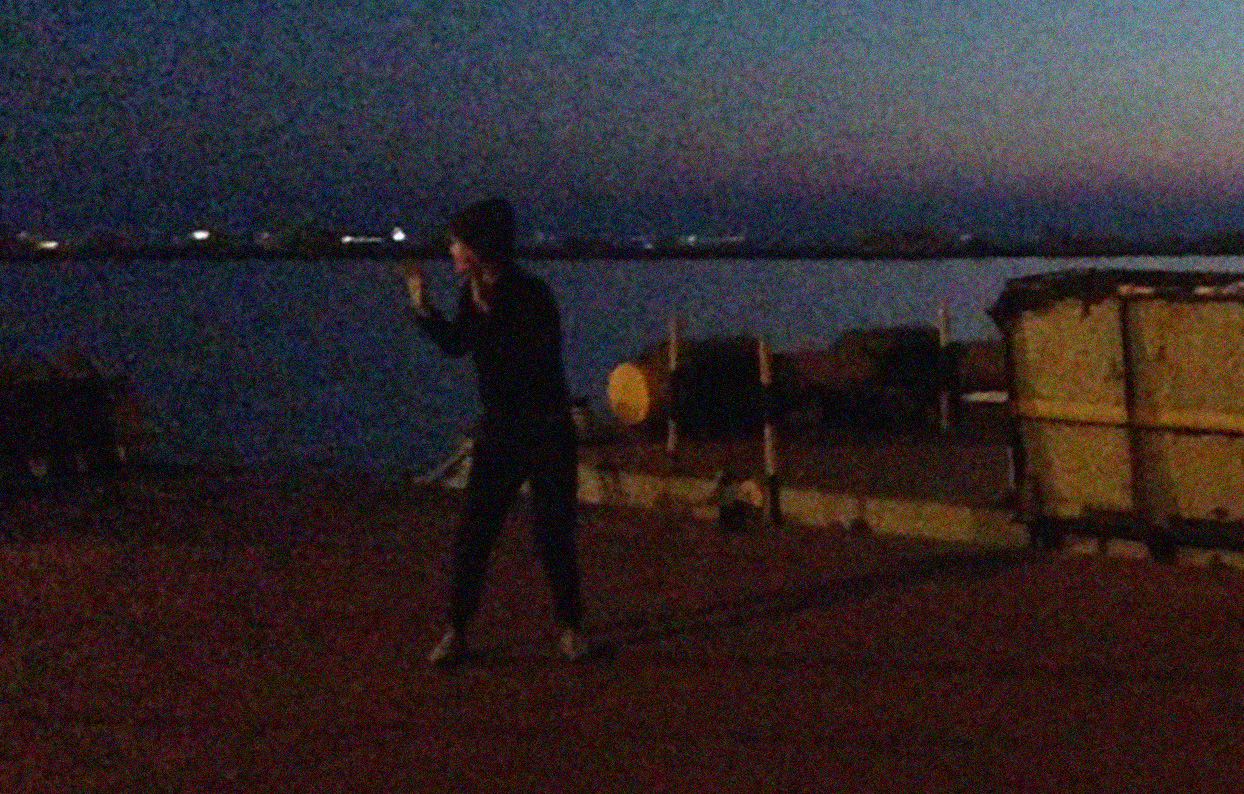
a car
clap
a couth
clack
a child
someone singing
a mouth
laugh-
sing-
lips
skin
a woman’s whispering
a door
fingers
face
a figure
a bus’
hums
a fan’s circling
a table’s
tap
sigh
noise
cups
clap
a step
a phone’s ringing
a dog
chair’s
jar
tick
sigh
punch
a man’s scenting
a wind
smack
scratch
skin’s
cold
calm
deep breathing
one moment!
I put a hand on my face
clap on my cheek
clap on it
Contingent
Jasmin Schädler
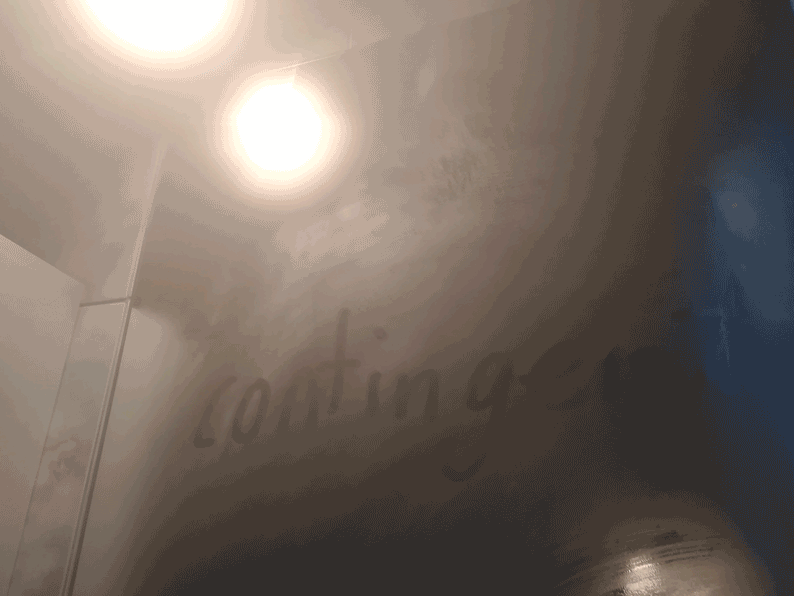
Con-tingent.
Com-tangere.
Together-touch.
I am dependent on your touch.
Without your touch I am uncertain to happen.
Your touch is without cause.
Sensing your touch without logical need.
Contingent.
Touch Together.
Cyborg Collective (The Temptation of Touch 1)
Florian Göttke
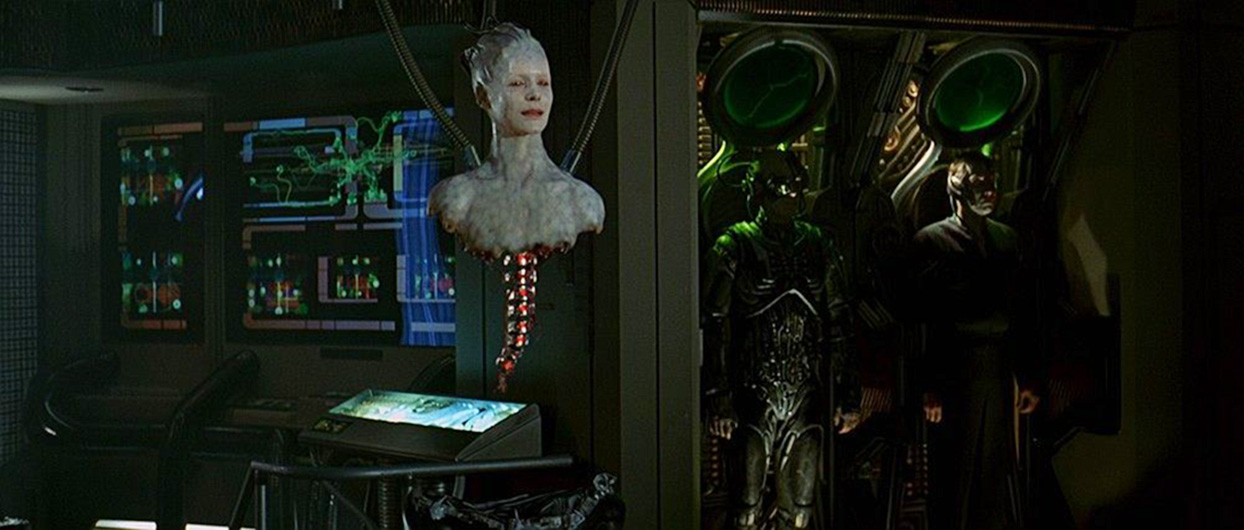
The cyborg represents one of the promises of cybernetics: the merging of human bodies and human consciousness with the machine. This vision promises connectivity, efficiency, and the prospect of eternal life when possible to upload human consciousness into the computer. The Star Trek series gave us a glimpse of where this development could lead, when the ‘Borg’ appear in the second season. The Borg is a collective being, a human-machine assemblage that forcibly incorporates human and alien individuals into the collective. The goal of the Borg is the advancement of human- and alien-kind through the optimal use of individual knowledge and the erasure of conflict through absolute connectivity and transparency – the ultimate, intimate and deepest touch.
The Star Trek movie First Contact from 1996 introduces a new figure at the centre of the collective: the Borg Queen. The Borg Queen embodies the sensual aspects of the collective: the collective as an erotic merging of flesh and machine: the overflowing consciousness of sensations, emotions and intellect. While the Borg Queen retains her individuality and steers the collective hive with her superior consciousness, the other – formerly individual – elements of the Borg are reduced to soulless operating drones, expendable for the greater good. The consequence of absolute cybernetic touch, it seems, is the loss of individuality and freedom. The promise of the cyborg is turned into a dystopian vision.
Diagnosis
Marianna Maruyama

Let me know how you feel. If something hurts, please don’t hesitate to tell me. How is the pressure?
The mind is in the fingertips. Searching the body for tender areas, tension, weak spots, the manual therapist is at once diagnosing an imbalance and treating it. Searching the body with fingertips and palms that think, the therapist feels closely for messages hidden within the tissue, wrapped in layers of protection, and overlooked for years. A way of seeing: the Japanese therapy anma, predecessor of shiatsu, was traditionally only practised by the blind. The hands-first diagnosis is made through touch, and the diagnosis is also the treatment.5 The encrypted messages of the body beg to be decoded; they manifest themselves in pain, fatigue and illness. The receptive and attentive therapist, a person fluent in the language of the body, offers the treatment.
Disembodiment
Ines Schärer
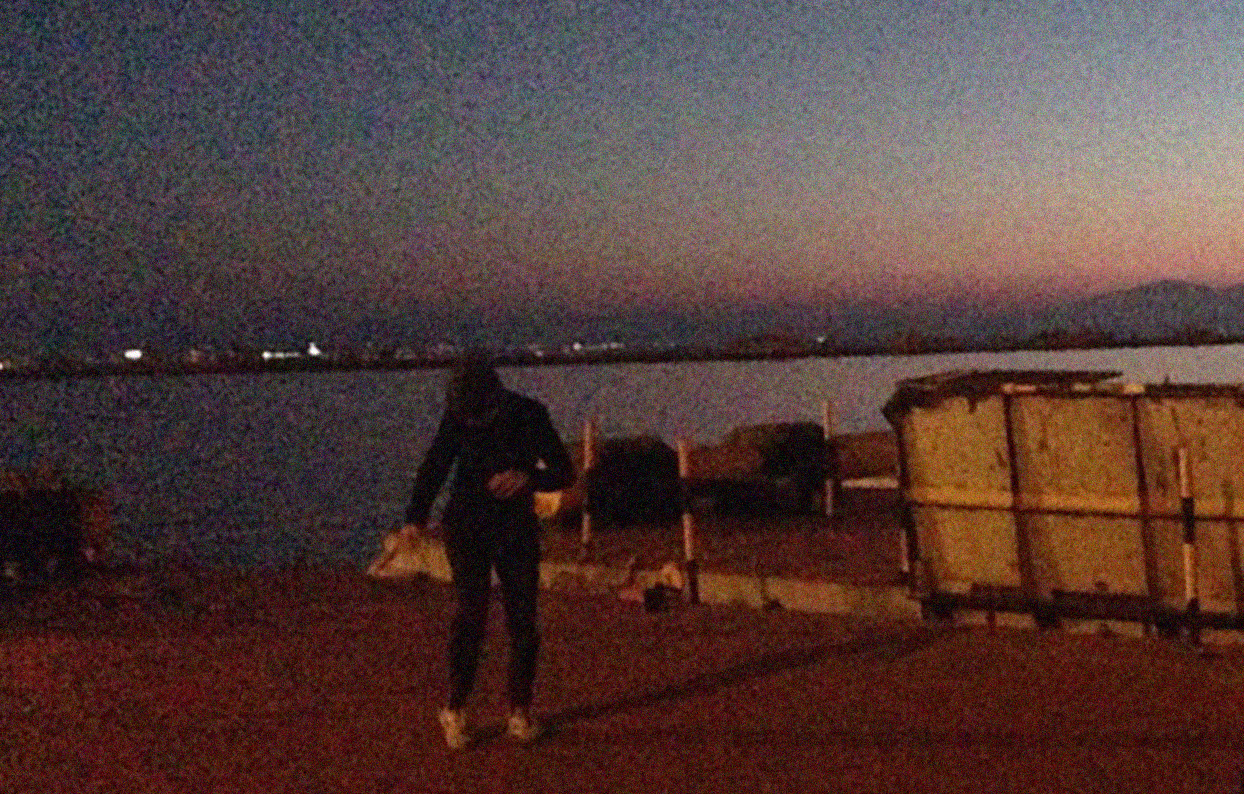
I remain silent. I know the door is open. I hear it. Whatever is moving inside the chamber, it moves slowly, and soundlessly. I try to open my eyes, to see. To see it. The lids are already open, the eyeballs are moving nervously. I see but I do not see. I’m intimidated by the density of the black. I almost can feel it, I almost can touch it. No. It catches me, holds me, holds me tight. It doesn’t let me move. I cannot see my arms, I cannot see my feet, I cannot see my legs. It pushes me, pulls me, scratches me. No, it lies silently on my shoulders, on my head, on my hair, covers me like a blanket, a soft cloth of black velvet. I notice the friction of the soft cloth on my skin, on my hair. It nestles around me, caresses me, whispers to me. I gratefully reach out my hands towards the blackness, without seeing them. I push it softly with my thumb, I form with my fingers as if it was potter’s clay. I dig a hole, try to make it bigger and bigger. I push with my palms, push it back. Here I am. I reclaim this position. Here I am. I say doubtfully. Do not take me over. Do not swallow me, I’m begging. But it laughs scornfully. It punches me and lets me sway. It solidifies itself just to make fun of me. It is rotating around me, driving faster and faster. I’m caught in the eye, in the centre. I feel dizzy. I’m worried about hard objects, I do not see, sharp edges that are moving closer and closer. I reach out my arms, my arms, without knowing how far they reach, lost in the darkness. I cannot distinguish anymore, what’s out there, my arms are out there, out there. I’m in the darkness. I’m darkness. I’m the darkness.
I hear a noise. We hear a noise. It stops moving. We both jerk, remain silent to listen. It is just the wood of the chamber’s wall groaning and moaning. I feel relieved. Here I am. Back in the chamber, back in this chamber. For a very short moment, it’s permeability is revealed. Darkness, darkness, I’m laughing about you. About me? About me, here, now.
The whispering of the wall is fading away, is gone. It throws the black velvet over me. Again!
Encounter
Aldo Ramos
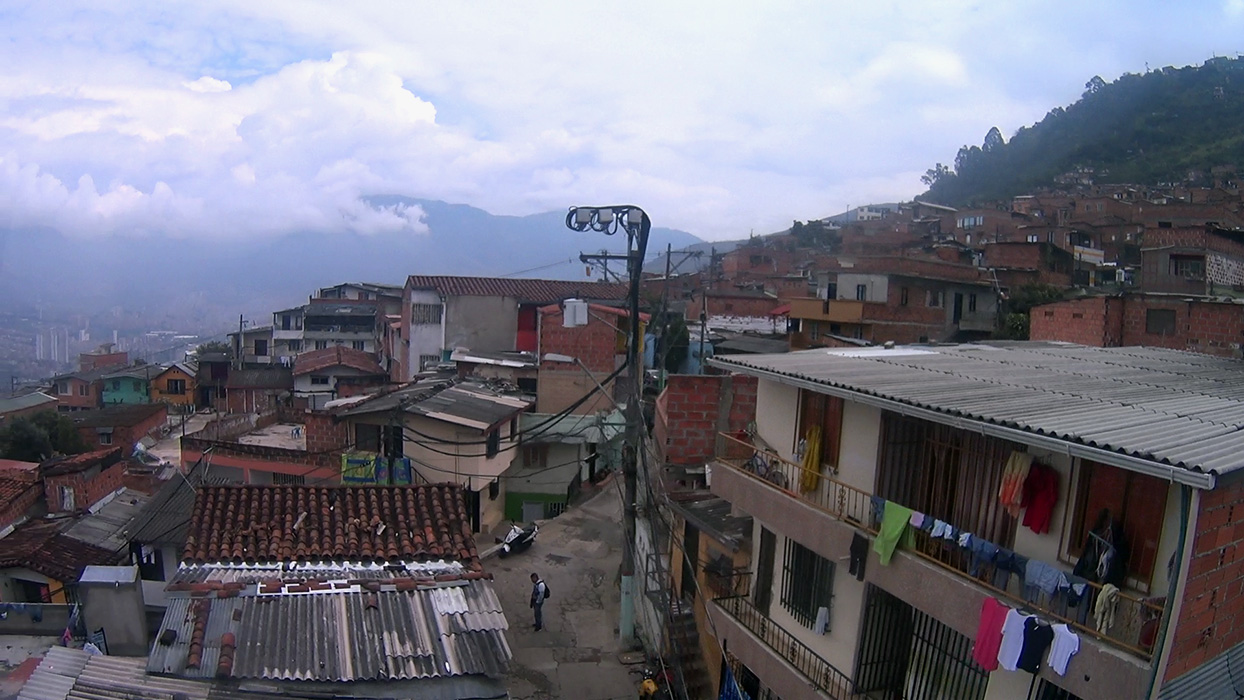
Walking, drifting around the city,
I don’t understand my surroundings.
I’m looking for something –
for what, I don’t yet know.
Without language I become powerless, vulnerable.
Here I’m a foreigner.
You were here, you are here.
The ancestrality of the land is alive in you –
in your body, and your presence.
Your presence feels different when you are here.
I hear you, but I don’t understand you.
If I don’t hear you, if i don’t see you, I feel you.
I arrived here not long ago, and you refer to me as your younger brother.
It is as if we come from different worlds, and we met in the same reality.
Extended Skin
Pitchaya Ngamcharoen

I move my body around, trying to distribute myself evenly in every corner, invading the kitchen. Spreading both arms, I fill up the kitchen’s air with my own. The kitchen tabletop is about a hand taller than the top of my pelvis and double the length of my arm.
Pans, big and small, hang on the wall, hugging a fridge that constantly hums, whispering to calm itself down. Ugly white light is about to touch my forehead and cut out my sight. The wall is painted mint green. Dried chilies and cherry tomatoes hang off it. Dried chilies appear many places in my life: my kitchen, shopping list, food, tongue and skin.
Nothing to eat, many things to smell.
Smells of the kitchen, the gathering of ingredients, return me to somewhere – each time it is a different place. Just like staring at my own reflection in two small mirrors. Seeing myself separately, upper and bottom separated, my feelings and skin. Spices that travel with me everywhere are absent here. Only basil is present. But it’s enough to take me, again, elsewhere, where I am my skin.
Fear
Mónica Lacerda

a tremor that transforms itself, sometimes rather slowly, some other times vertiginously, in a sticky matter. a tremor that changes its form each time it’s touched. fear can dwell where touch is unrequited. one mutes the reflex to hear what’s beyond the background noise. a tremor. a trace is left each time we feel it racing all the way up from where we thought one couldn’t be reached.
the fear is a body of whichever matter that takes up space in proportion to our unwillingness to acknowledge it. so powerful is it that it can seize all our muscles and release them only as spasms. to suppress marks both what’s hidden and what is on the surface. so heavy it can freeze oneself in the blink of an eye. a crack that draws a rupture. a rupture that draws more cracks.
Friction 1
As Resistance.
Alejandro Cerón

Meet the resistance one object or surface encounters when moving over another. Here, objects are understood as plateaus, topological spaces in which there are no straight lines of measurable value.6 On the one hand, distance provides us with space to move, see and breathe. On the other hand, when taking distance, we might see opposing objects, surfaces or ideologies from outside.
To be part of nothing or nowhere carries inconveniences. Yet this is not the worst thing that can happen, as we can use this space to ponder, to rehearse. We can treasure the exciting perhaps until the moment arrives, then we will have to make up our minds, make a decision, compromise; otherwise somebody will decide for us, freeing us from that accountability, eroding our agency. That would be unfortunate.
The distance between what these words intend, and what you receive, is a spatial promise: it is a length of suspended time. But how do we get rid of time as a real abstraction, a specific form of ‘conceptual domination’? The only thing true about truth is that it’s a joke. 7 Suppose we stop and wait, read and repeat. Repetition is a sign of compromise. We might have understood at last, that captive in our compromise we are free from having to decide.
These words speak – we see what they say – much as how the ancient trees, gushing streams and lichen-encrusted boulders once spoke to our oral ancestors.8
Friction 2
As Interruption.
Alejandro Cerón
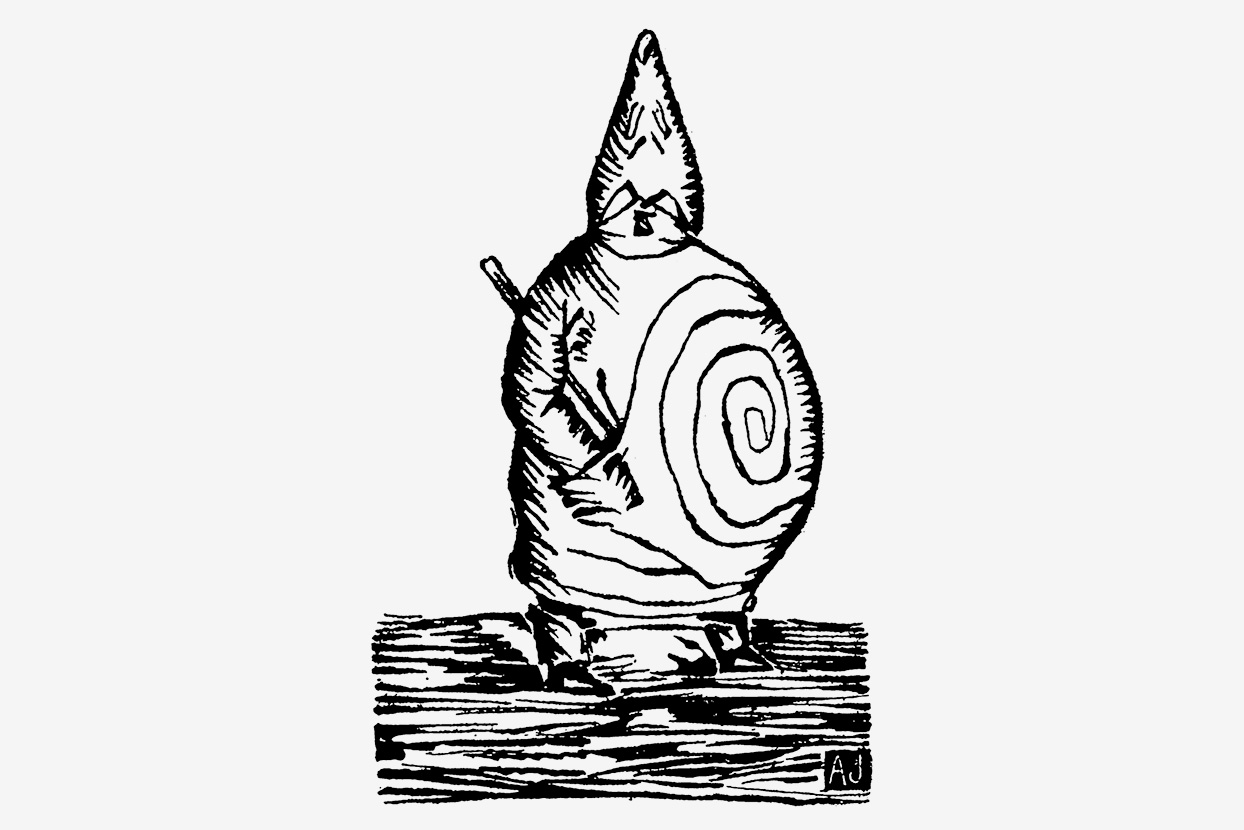
Pshit!9 We are both, all the time, producing and disrupting normality. Pshit! Will you pick a side already?! If there were time there would be no gap between practice and theory. If we had time, we might, fearlessly improvising, give more way to practising what we preach: that is, to actively resist the separation between body and mind, thought and action.
Oscillating back and forth, in a state of constant rehearsal, aware of the friction it generates, I negotiate the amount of interruption in this text, where meaning seems appositional.10 As if there is intention in all of this. Well, there is: friction is born of the relation between an intention and resisting that intention. If negative capability11 sharpens our study,12 it can cut through conventions. So, what is it that lubricates and thus softens our resistance?
Interrupting institutional inertia might grant us some time. Let’s think, for example, that the world is full of beings, only some of which are human. There are bacteria in our stomachs affecting our mood, sleep, stress. Life is always lived in relation with others.13
Internal Touch
Pitchaya Ngamcharoen
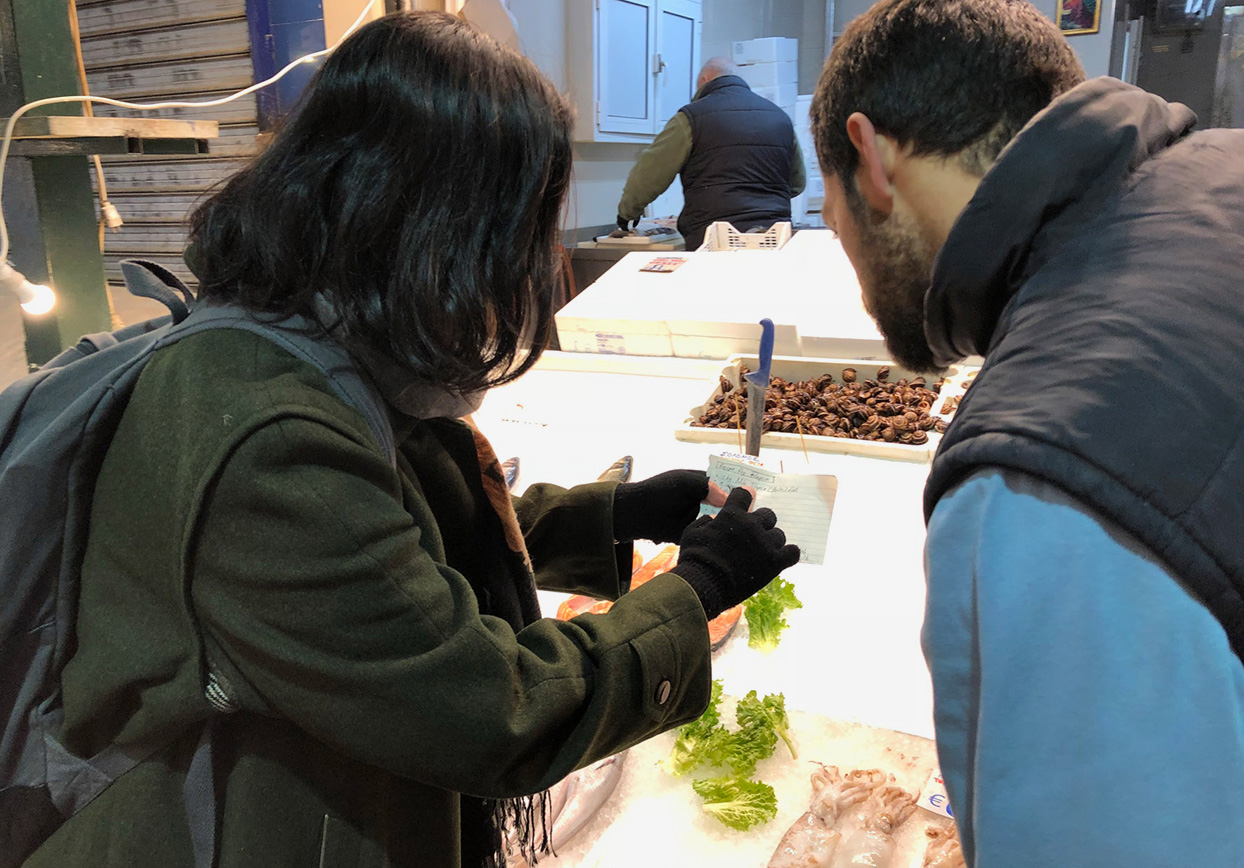
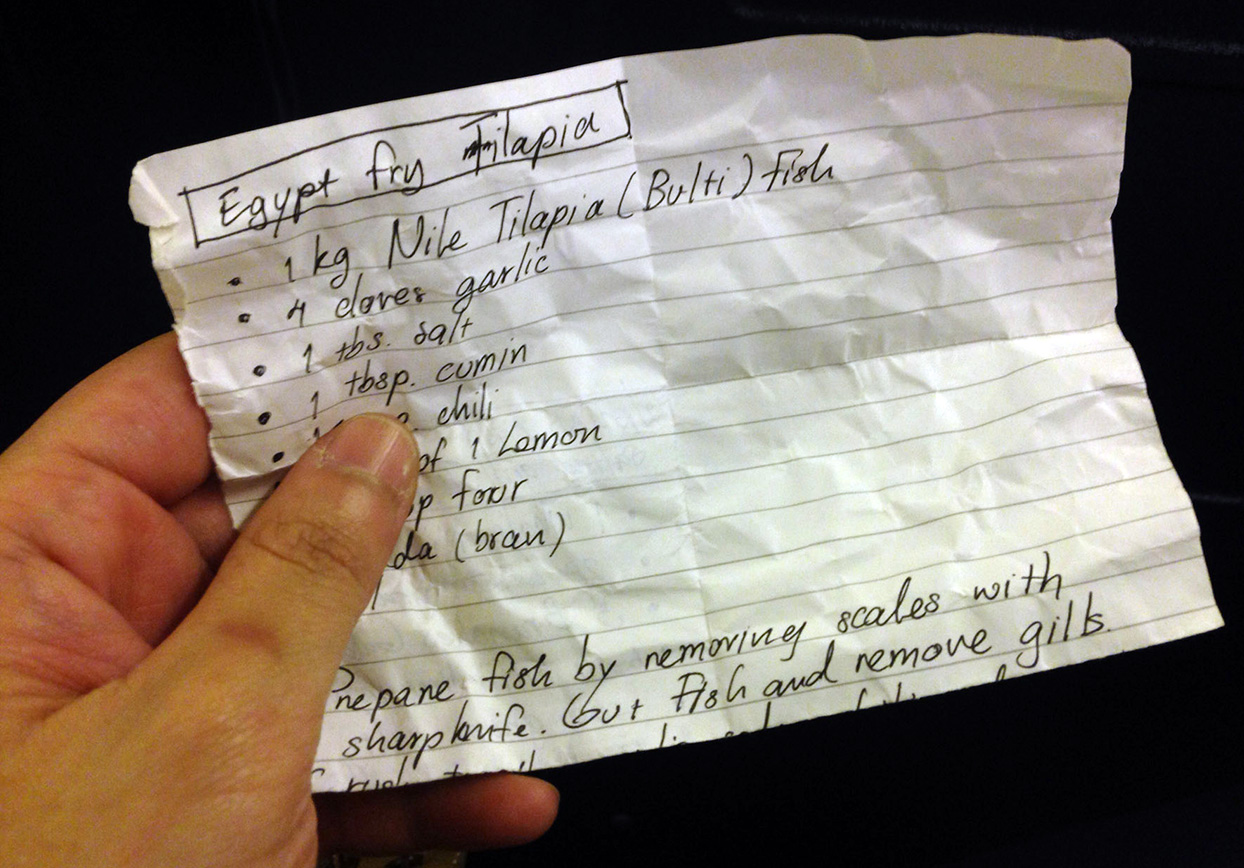
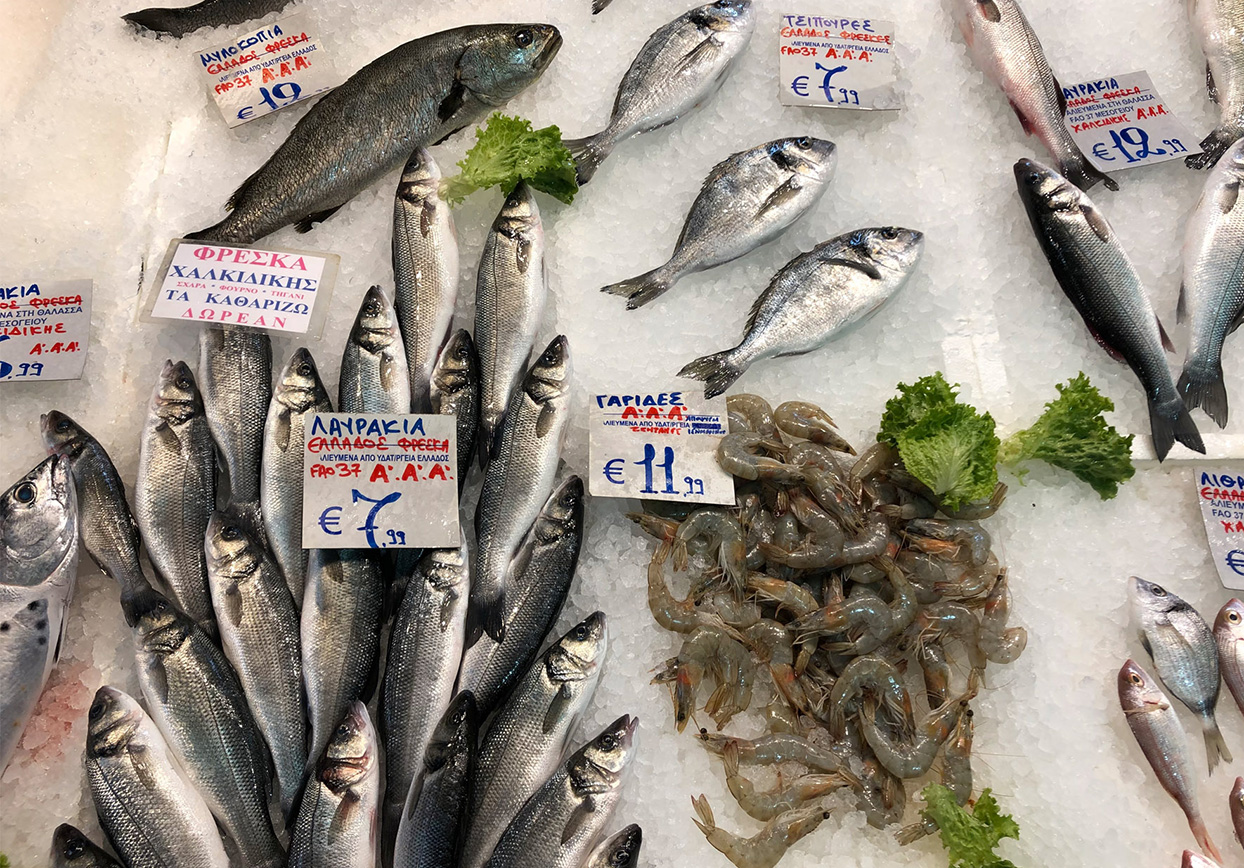
‘But it is not permitted to them (i.e. the priests) to taste of fish. […] and of fish also they esteem that which is called the lepidotos to be sacred, and also the eel; and these they say are sacred to the Nile.’
—Herodotus, Histories II (aroud 440 BCE)
1 kilogram Nile Tilapia (Bulti) fish
4 cloves garlic
1 teaspoon salt
1 tablespoon cumin
½ teaspoon chili
juice of 1 lemon
½ cup flour
radda (bran)
oil for deep frying
Prepare fish by removing scales with a sharp knife. Gut fish and remove gills. Crush together garlic, salt, chili and cumin. Add lemon. Stuff fish with the mixture. Cover fish with radda. Fry in oil until browned.14
‘Today, farmed tilapia remains an important food source for Egypt. It is the cheapest source of domestically produced animal protein in the country, which is the world’s third-largest producer of tilapia.’15
1 whole Nile Tilapia
2 lemongrass stalks
5 branches galangal
6–10 Kaffir lime leaves
300 grams salt
100 grams rice/wheat flour
½ cup water
Prepare fish, cut open, scoop out intestines, remove gills (make sure not to not remove scales). Smash lemon grass, Galangal and hand-ripped Kaffir lime leaves. Stuff all herbs into fish gut. Mix salt and flour with a bit of water. Cover fish with mixture. Grill on low fire.16
‘50 Nile Tilapias from Japan were introduced to Thailand in 1965 as a gift from the Emperor of Japan, Akihito, once he was a Crown Prince, to King Bhumibol Adulyadej.’
King Bhumibol Adulyadej did not eat Nile Tilapia as a child so that he might honour good relations between Thailand and Japan.17
Phantom Pain
Jorinde Seijdel
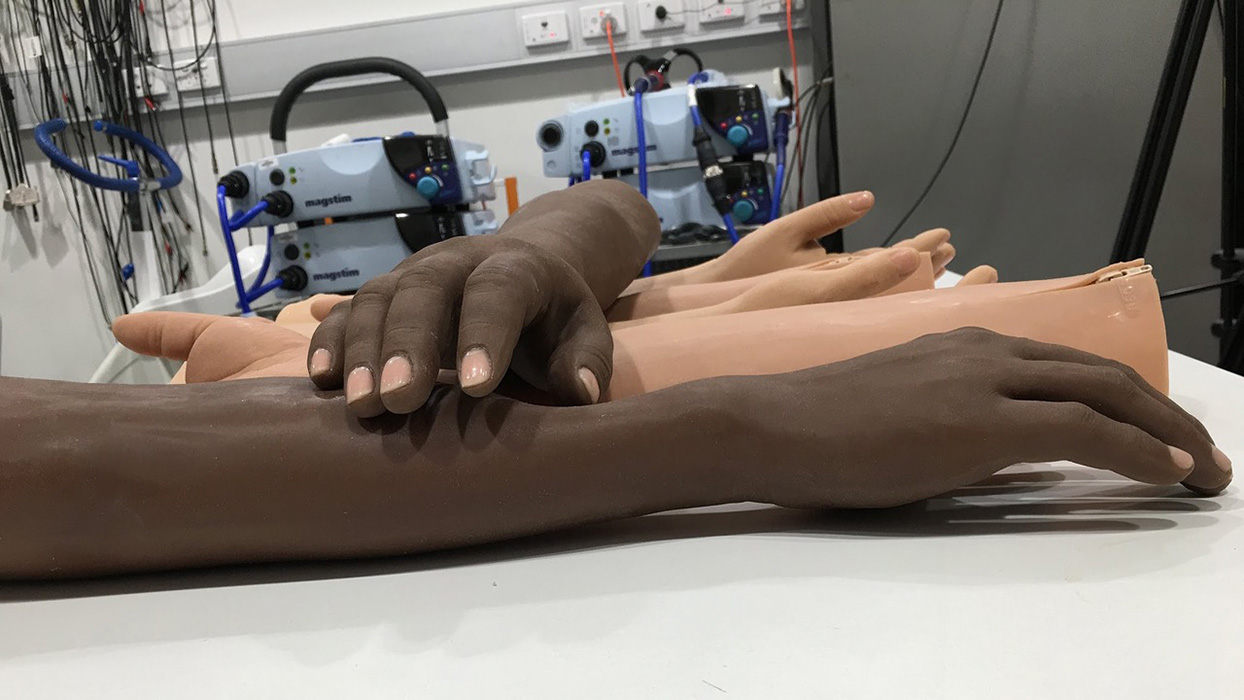
Phantom pain involves the sensation of pain in a part of the body that has been removed. Sensations are recorded most frequently following the amputation of an arm or a leg, but may also occur following the removal of a breast, the teeth or an internal organ. Phantom pain is often described as burning, stabbing and throbbing. Early theories saw phantom pain as proof of the immortal soul or part of the Freudian process of mourning the amputated limb. Nowadays, the standard explanation is that the ghostly appendages result from confusion in the brain’s map of the body. However it might be, this kind of pain must in some sense be similar to how a body feels – an individual body or a collective body, any body – if it is shut off from where it belongs or what or who it is. Something is cut off from this body so that it becomes an amputated body. Who decides on this cutting, about this taking away and withholding? What happens to the separated limbs? Maybe the cut-off body parts form new bodies, hybrid bodies, multiple bodies. These phantom bodies can still contain the desires and subjectivities of the bodies they are taken from and are therefore subversive bodies. Bodies that were not supposed to be. Subversive and mirrored bodies that keep on haunting the original body transforming it into a phantom. There is no original body.
Pleasure
Mónica Lacerda

to stay in pleasure. to run from pleasure. the instant of erotic desire. to stay. to run. what happens in the split second when one spins between staying and running. spinning at a speed that motion appears as an intense stillness. what’s the blur in the in between.
to fall in. time gallops in a fleeting motion. it has no limits, it is a delightful vertigo. the pleasure rooted in the split second is palpable. to fall in now seems to have been inevitable. to fall in, the moment of living hope extended. to fall for falling in. to fall for falling.
power and value are both obstacles and opportunities that grow in the wrestling that happens when falling. the possibility of fulfilment takes oneself deeper into one’s struggle. to fight for the right to fall in and fall out. pleasure keeps one spinning.
Rubber Hand Illusion
Jorinde Seijdel
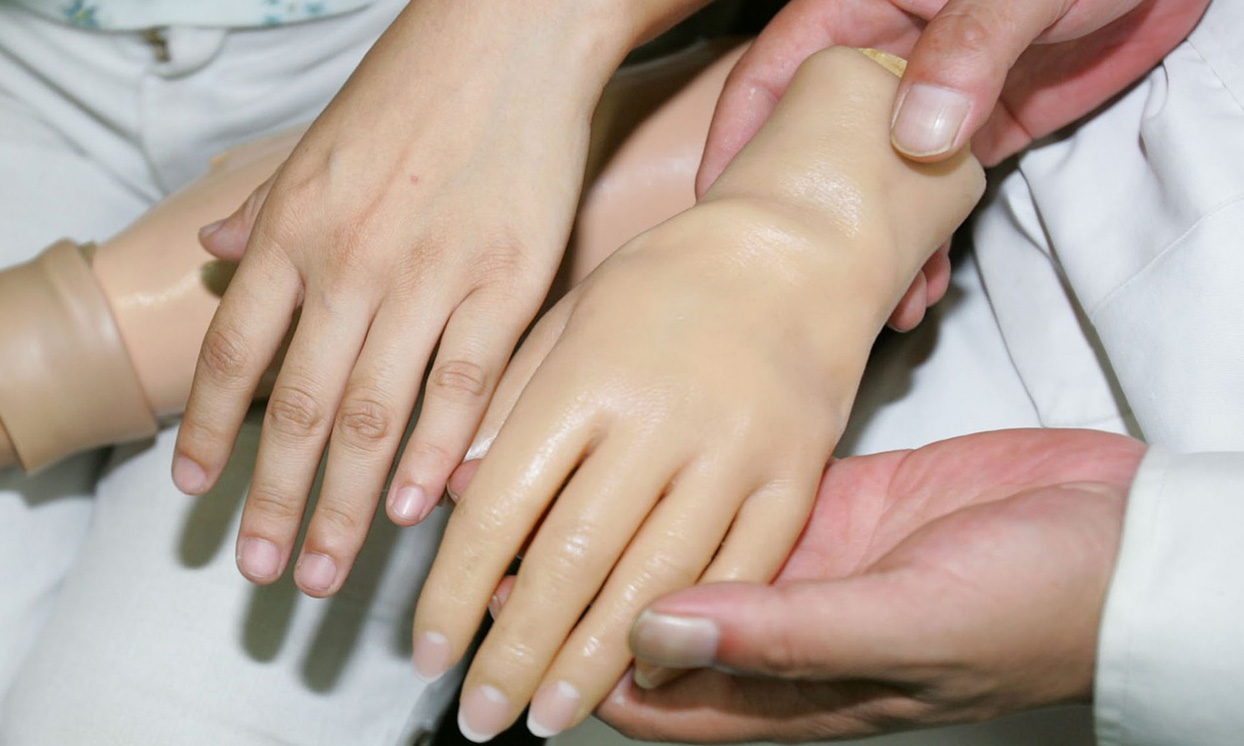
Neuro-philosopher Thomas Mezinger claims that ‘no such things as selves exist in the world’. In Being No One: The Self-Model Theory of Subjectivity (2003), he argues that there is only a ‘phenomenal self-model’ (PSM) that is a process rather than a thing and a virtual construction of the brain. To support this proposition, Metzinger refers to – among many other things – the ‘rubber hand illusion’, an experiment that demonstrates how we can experience a fake hand as part of our self and even feel a sensation of touch on the phantom hand. How does this work? Subjects are positioned with their left hand hidden out of sight. They see a lifelike rubber left hand in front of them. The experimenters strike both the subject’s hidden left hand and the visible rubber hand with a paintbrush. The experiment shows that if the two hands are stroked synchronously and in the same direction, the subjects begin to experience the rubber hand as their own. When asked to use their right hand to point to their left hand, most of the time they point toward the rubber hand. The ontological and neuroscientific implications of this are numerous and highly confusing. What if we have no self? What if we can feel another body as our self? Apparently bodies cannot be claimed, they do not have only one author. We can feel other bodies as if they belong to us. Other bodies can feel us. This offers liberating perspectives. Nobody ever had or was a self. Bodies and selves are interconnected and share responsibility.
Sentipensar
Aldo Ramos
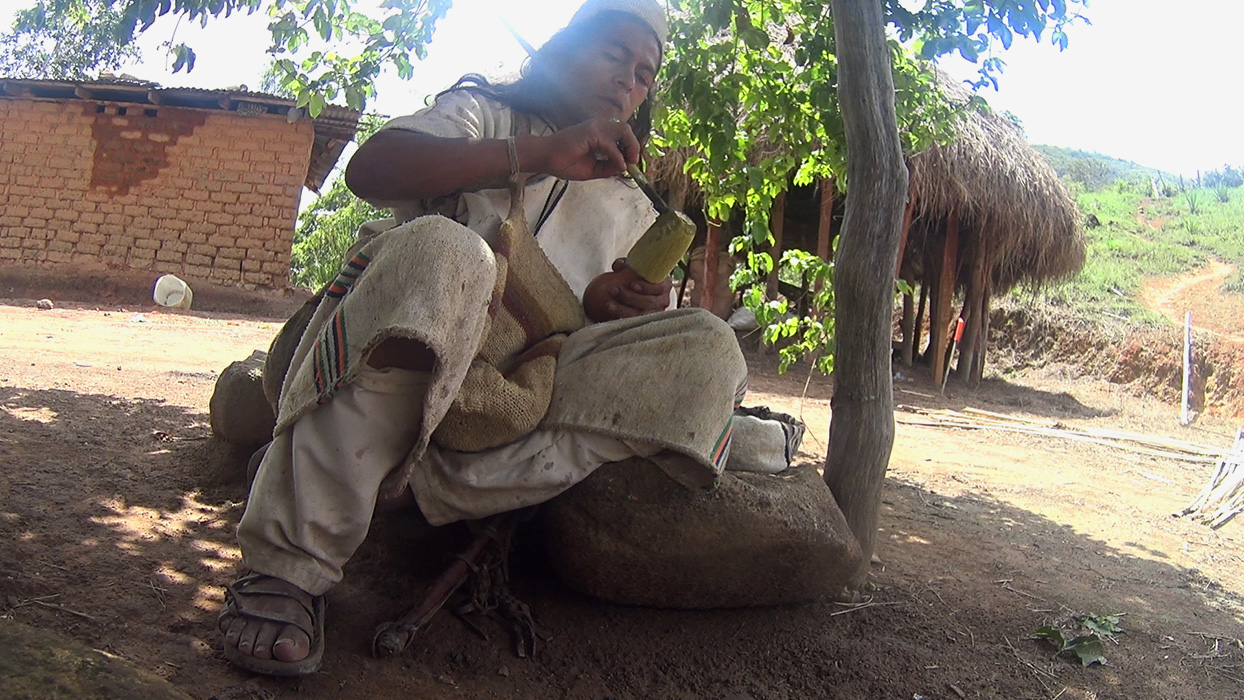
A fabric of thought,
the one you carry in your hands,
it grows slowly like a tree.
A fabric of thought,
in your bag,
a woman’s thought.
Women share your cosmovision.
It is with you all the time, at any moment.
You do it without propose, not looking for a final product.
It is an action that has meaning only here and now.
As if in a different reality,
where no divorce between emotion and reason is necessary,
where it is not possible to separate thinking from feeling,
where mind and heart cannot be separated.
Smudge
Anja Khersonska
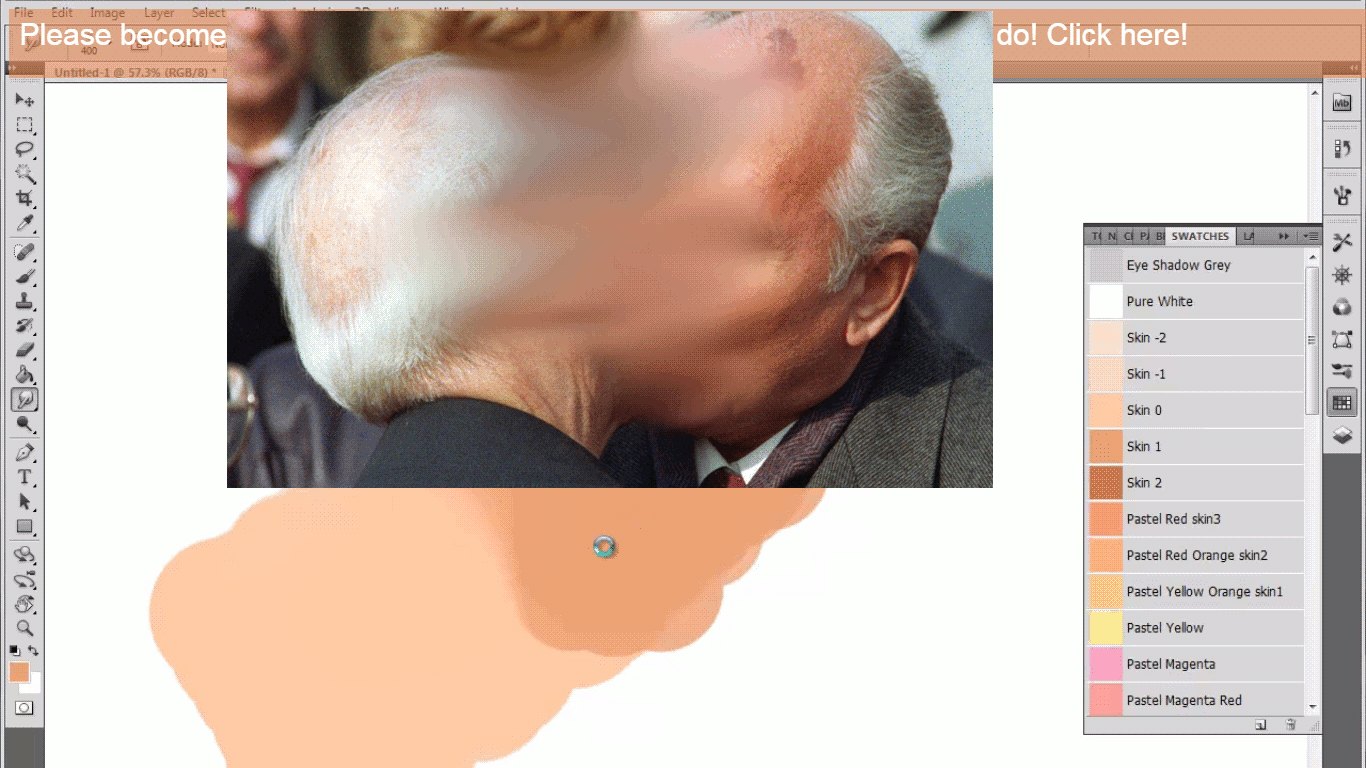
Example sentence:
I am smudging with smb.
Example sentence:
I [love you] smudge with you.
Why love hurts.18
In love, the relation takes the form of a line from the loving subject to the beloved object. Smudging this line can annihilate both of them and create something else that can be described as blur,19 humus,20 slime,21 swarm.22
A smudge tutorial:
I'm gonna lay in a skin tone. (…) And my second shade skin tone. (…) If you try and you drag like this really hard first off your computer takes forever (...). I gotta wait for this to get done (…) and I'm still talking to you and I'm still waiting for this thing to blend. I'm freaking out from what I just did! Uhm, I'm sorry I haven't made any videos lately. (…) I'm sorry but a lot has been on my plate, I got back from Mississippi, all of my commissions are gone, all of my paid commissions, so I've got a few free ps I gotta do for some friends, uhm but I'm praying to get some new client soon, but I also picked up a new toy, I picked up a motorcycle and I bought it from a friend for really cheap and I've been working on it so – in the meantime – okay! Here we go! So that looks pretty well blended but you see how long that took, that's not gonna – so let me undo that setting.23
Synesthesia
Jasmin Schädler
Together-sensing
maybe feeling through listening
a tingling sensation on the scalp.
With 16
private Latin lessons.
Hunchback, oily hair and scaly skin
her voice was calm and of unstable pitch
I saw her once a week
overheated and filled with a scent of scalp oil.
A warm and calm state of relaxation
a delightful tingling on my scalp
touched in an intimate way
without physical engagement
auditory-tactile synthesis.
Touch
Jasmin Schädler
Making physical contact
The unconscious says:
Uncomfortable sensuality
Tock tock, toccare
Knock, strike, offend!
Tokkon, tukkon, tukkona, tukkijana
Being drawn
Being jerked
Being knocked
Being stroked
Being offended
Noli me tangere
I exist without your touch.
Jerking off a burst of seeds.
Untouchable Data (The Temptation of Touch 2)
Florian Göttke

The plot of the movie First Contact sets up a final showdown between the Enterprise and the ‘Borg’, in which Data figures as the central antagonist of the Borg Queen. Data is the other promise of cybernetics, which is machine-learning: he is an AI with a logical intelligence vastly superior to that of humans. Data is characterized by the logic of the algorithm: nerdy, rational, clean, and asexual. As the only android of his kind, he is a hyper-individual. Dedicated to learning and self-improvement, his goal is to understand the human faculties that lie outside of logic: empathy, compassion, surprise, curiosity, humour, and fear.
While the human actors and their technology are no match for the ever adapting and evolving Borg, Data is the only one of the Enterprise crew, who cannot be assimilated. Here, the movie activates the old female-male stereotype of the Bible: the corruption of the male mind by the female flesh by the temptation of touch, the temptation of communion. Aware of Data’s incompatibility with the collective, the Borg Queen tempts Data to join her by offering him exactly what he is striving for: the promise to become even more human. The Borg Queen promises Data the emotional, sensual, erotic, orgiastic experiences the collective has to offer. She has a piece of human skin grafted onto his endo-skeleton and in a moment of seduction, she blows lightly over the hair of the naked skin. Data feels the overwhelming excitement of skin sensing the ever so light touch. Data seems to relent and at one moment in the movie the two merge into a … kiss.
Allowing the kiss is a deceptive move by Data, a ruse to distract and ultimately destroy the Borg Queen. Data resists the temptation and rejects her offer. Data proves to be incorruptible. His tragedy is, though, that by proving to be incorruptible, he proves to be untouchable as well.
Uncurl
Anja Khersonska

Lisa Marie Schmitt made a video called Ich, Mimose,24 touching a mimosa plant and indirectly comparing its response to her own inherited phantom knee pain, which women in her family experience as empathy. Their knees hurt when they witness physical pain experienced by other people. The mimosa leaves curl by touch.
A: Holding them near your heart can help them get used to you, because they can hear your heartbeat and realise you're an animal too.
B: Take baby steps. … Some hedgehogs will always be grumpy and nervous about you and will never trust you.25
Uncurling scared hedgehogs can be challenging.
B: So I knew it was a belly and I was aware of the shape of it, I was aware of the volume of it … and that was it. And then in my head I was – and now I kind of forgot it – I was supposed to find one or more men that have round bellies. Like, round belly volume. And then I found this belly and then because I found it I was kind of like, yeah, cool, now I should kind of keep it and make sure it stays there. I also wanted to have my … to feel this volume as much as I can and so I stretched my arm all the way around the belly. And then at some point you put your hand on my arm and –
A: Yeah, because the thing was that, I think I wasn’t sure, I think either you or me, like, one of us was a plant. And there was supposed to be a way, the right way, to, like, touch this plant. I was like, I was feeling like you were sometimes doing a good job and then sometimes it was kind of wrong and you should, like, change a bit. And then I was taking your hand and I just moved it around.26
1. Stefano Harney and Fred Moten, The Undercommons: Fugitive Planning & Black Study (Minor Compositions, 2013), 105.
2. Hypatia Vourloumis, ‘Ten Theses on Touch, or, Writing Touch’, in The Haptic: Textures of Performance, special issue, Women and Performance: A Journal of Feminist Theory 24, no. 2–3 (2014), 232–38.
3. ‘When I say operations management notices logistics what I mean is that until this point, operations management restricted itself to what it could oversee within the walls of the factory. It [sic] concerns began at the entrance dock and ended at the exit gates.’ Stefano Harney, ‘Jay-Walker. How can it be that jay-walking has become punishable by death?’ Transversal, 9 September 2015, www.transversal.at.
4. Ibid.
5. ‘The real meaning of touch is making natural, easy, human contact. Knowing what will affect each individual is diagnosis.’ Akinobu Kishi and Alice Whieldon, Sei-Ki: Life in Resonance – The Secret Art of Shiatsu (London: Singing Dragon, 2011), 80.
6. The shortest distance between two points is a straight line. But in non-Euclidean space, as in topological space, there are no straight lines of measurable value. See N. Salazar-Sutil, ‘Set in Poland, that is to say Nowhere: Alfred Jarry and the politics of topological space’, in Performance and the Politics of Space: Theatre and Topology, ed. Erika Fischer-Lichte, Benjamin Wihstutz (London Taylor & Francis, 2013).
7. Being lies outside time, in a duration that includes past, present and future. Time is a ‘closed curved surface’ that allows for such folding (possible and imaginable), which in turn makes the unimaginable possible. No longer conceived as linear, time carries within experience sheets of the past and future, virtually present. See Alastair Brotchie and Paul Edwards, Collected Works of Alfred Jarry Volume 1 (London: Atlas Press, 2001).
8. Reading is an intensely concentrated form of animism, one that effectively eclipses all of the other, older, more spontaneous forms of participation in which we once engaged. ‘To tell the story in this manner – to provide an animistic account of reason, rather than the other way around – is to imply that animism is the wider and more inclusive term, and that oral, mimetic modes of experience still underlie, and support, all our literate and technological modes of reflection. When reflection’s rootedness in such bodily, participatory modes of experience is entirely unacknowledged or unconscious, reflective reason becomes dysfunctional, unintentionally destroying the corporeal, sensuous world that sustains it.’ See David Abram, The Spell of the Sensuous (New York: Pantheon, 1996).
9. Translated from the French merdre, pshit! is the first word spoken in Alfred Jarry’s play Ubu Roi for its 1896 presentation at Théâtre de l’Œuvre, which generated a riot among the outraged audience.
10. ‘Can this being together in homelessness, this interplay of the refusal of what has been refused, this undercommon appositionality, be a place from which emerges neither self-consciousness nor knowledge of the other but an improvisation that proceeds from somewhere on the other side of an unasked question?’ See Harney and Moten, Undercommons.
11. ‘Negative capability’ was first used by John Keats in 1817 to characterise the capacity of the greatest writers for pursuing a vision of artistic beauty, even when it leads them into intellectual confusion and uncertainty, as opposed to a preference for philosophical certainty over artistic beauty.
12. See ‘study’ as described in Harney and Moten, Undercommons.
13. See Graham Harvey, Animism: Respecting the Living World (New York: Columbia University Press, 2006), 11.
14. Magda Mehdawy and Amr Hussein, The Pharaoh's Kitchen: Recipes from Ancient Egypt's Enduring Food Traditions (New York: American University in Cairo Press, 2010), 84.
15. See Mona El Azzazy, ‘Cairo’s Chefs Take to Farmed Tilapia’, The Fish Tank, 28 March 2017, blog.worldfishcenter.org.
16. Translation by author, see www,eveleighmarket.com.
17. See www.manager.co.th.
18. See Eva Illouz, Why Love Hurts: A Sociological Explanation (Cambridge, UK: Polity Press, 2012).
19. See Fred Moten, Black and Blur (Durham, NC: Duke University Press, 2017).
20. See Donna Haraway, Staying with the Trouble, Making Kin in the Chthulucene (Durham, NC: Duke University Press, 2016).
21. See Jacqueline Dalziell, ‘Microbiology as Sociology: The Strange Sociality of Slime’, in What if Culture was Nature all Along?, ed. Vicki Kirby (Edinburgh: Edinburgh University Press, 2017).
22. See Dan Hassler-Forest, Science Fiction, Fantasy, and Politics, Transmedia World-Building Beyond Capitalism (London: Rowman & Littlefield, 2016).
23. ‘Blending in Photoshop’, Time:2:Draw, 3 August 2011, https://www.youtube.com/watch?v=-rHjCWFSh7g.
24. See Lisa Marie Schmitt, Ich, Mimose, 2017, www.vimeo.com.
25. Hedgehog Central Forums, discussion, 14 July 2011, www.hedgehogcentral.com.
26. Conversation between author and Bogdan Obradović, n.d.